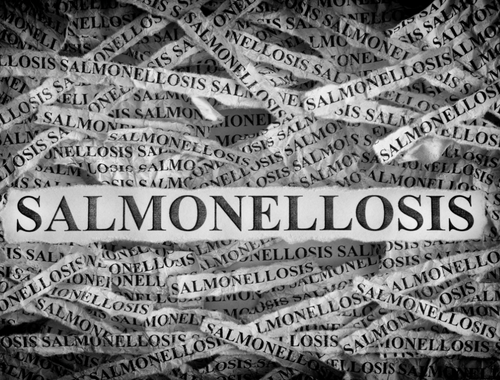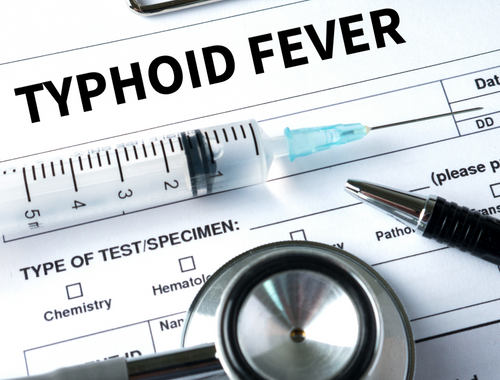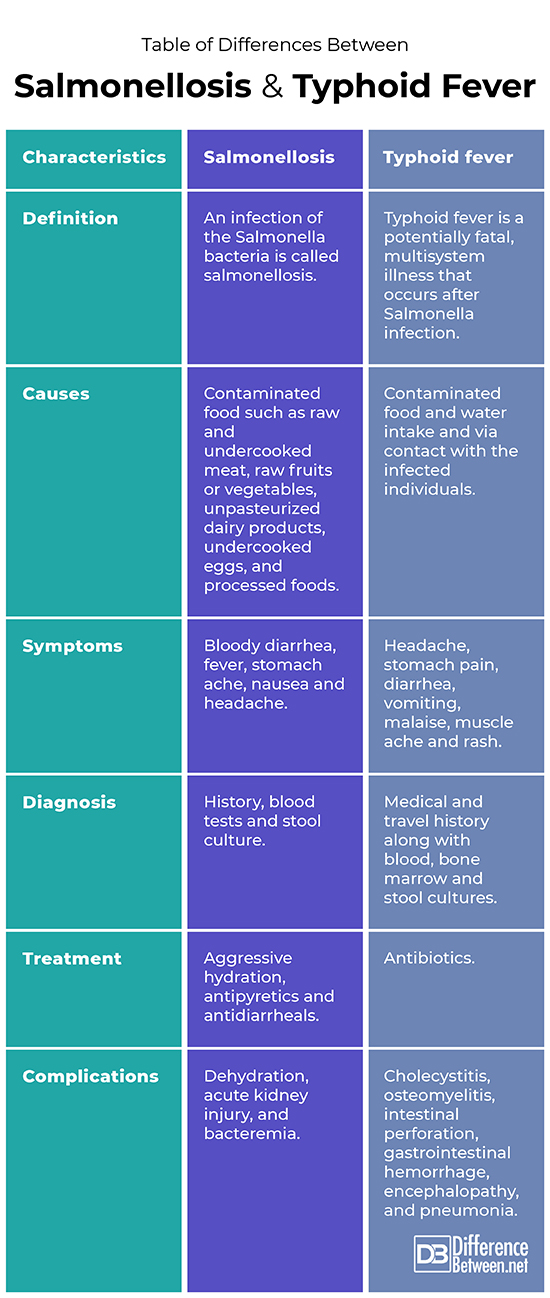Difference Between Salmonellosis and Typhoid Fever
Salmonella bacteria is one of the common culprits of food borne infections worldwide. A typical infection of this bacteria is called salmonellosis. Typhoid fever is a potentially life-threatening multisystemic disorder that occurs after specific Salmonella species infect that gastrointestinal tract. Concisely, typhoid fever or enteric fever is a serious version of Salmonellosis.

What is salmonellosis?
Definition:
Infection of Salmonella bacterium that causes a medical condition which is called salmonellosis. It manifests as low-grade fever, pain, abdominal cramping, and an upset stomach. The disease is self-limiting in most cases and most people get well on their own in 3 to 7 days.
Symptoms from salmonellosis:
Symptoms of salmonella arise within a few hours to a few days after the Salmonella infection. Intestines are the main organ affected and the symptoms are classic for enterocolitis. Bloody diarrhea, fever, stomachache, nausea and headache are few of the common manifestations in salmonellosis.
How do we get salmonellosis /Causes:
Humans and animals are hosts to Salmonella; they carry the organism in their intestines and feces. Contaminated food intake is the main cause of salmonellosis. Examples of frequently contaminated food sources include raw and undercooked meat, raw fruits or vegetables, unpasteurized dairy products, undercooked eggs, and processed foods. Untreated water intake and poor handwashing are also prime causes of salmonella infection. Furthermore, pets also carry this bacterium.
Diagnosis of salmonellosis:
The physician will carry out blood tests and ask for stool samples to detect the bacteria.
Treatment for salmonellosis infection:
Adequate hydration is the key to rapid settling of salmonellosis, especially in adults and elderly. If diarrhea is explosive and not subsiding, oral rehydration solution and medications such as loperamide are prescribed. Antipyretics are given in case of fever.
Complications related to salmonellosis infection:
Salmonellosis is not life-threatening. In immunocompromised individuals the development of complications can be particularly dangerous. Complications of salmonellosis include dehydration, acute kidney injury, and most importantly bacteremia that affects various body systems and presents as endocarditis, osteomyelitis, urinary tract infection and meningitis.

What is Typhoid fever?
Definition of Typhoid fever:
Typhoid fever is a serious multisystemic illness that is caused by Salmonella typhi and rarely Salmonella Para typhi bacteria. It is a disease of developing countries that occurs secondary to contaminated food and water intake.
Symptoms related to Typhoid fever:
As the name suggests, typhoid fever or enteric fever manifests as a fever that is high grade and sustained. Other symptoms include headache, stomach pain, diarrhea, vomiting, malaise, muscle ache and rash.
Causes related to Typhoid fever:
Typhoid fever occurs via the fecal oral transmission or close contact with the carrier of enteric fever. In developing countries, drinking and eating contaminated food and water often results in typhoid fever.
Diagnosis related to Typhoid fever:
Medical and travel history is especially important in diagnosing the condition. Blood, bone marrow and stool cultures are also taken for a definitive diagnosis.
Treatment for Typhoid fever:
Antibiotics are the backbone for the eradication of enteric fever. It is the only effective treatment for the condition. However antibiotic resistance is a particularly alarming challenge in the developing countries that can lead to potentially fatal complications. Fluid intake is encouraged in typhoid fever.
Complications with Typhoid fever:
Complications of typhoid include cholecystitis, osteomyelitis, intestinal perforation, gastrointestinal hemorrhage, encephalopathy, and pneumonia.
What is the difference between salmonellosis and typhoid fever?
Definition of salmonellosis vs typhoid fever:
An infection of the Salmonella bacteria is called salmonellosis. Typhoid fever is a potentially fatal, multisystem illness that occurs after Salmonella infection.
Symptoms of salmonellosis vs typhoid fever:
Bloody diarrhea, fever, stomach ache, nausea and headache are common features of salmonellosis. Typhoid fever has a wide spectrum of symptoms that includes headache, stomach pain, diarrhea, vomiting, malaise, muscle ache and rash.
Diagnosis of salmonellosis vs typhoid fever:
History, blood tests and stool culture are required for the diagnosis of salmonellosis. Typhoid fever is diagnosed by blood, bone marrow and stool cultures in addition to medical and travel history.
Causes of salmonellosis vs typhoid fever:
Contaminated food and water intake is the main cause of salmonellosis. Examples of such include raw and undercooked meat, raw fruits or vegetables, unpasteurized dairy products, undercooked eggs, and processed foods. Contact with pets can also cause salmonellosis. Typhoid fever results from contaminated food and water intake and via contact with the infected individuals.
Treatment of salmonellosis vs typhoid fever
Aggressive hydration, antipyretics and antidiarrheals are used to succumb salmonellosis. Typhoid fever needs antibiotics for resolution.
Complications of salmonellosis vs typhoid fever
Complications of salmonellosis include dehydration, acute kidney injury, and bacteremia that can infect multiple organs. Complications of typhoid fever include cholecystitis, osteomyelitis, intestinal perforation, gastrointestinal hemorrhage, encephalopathy, and pneumonia.
Table of differences between salmonellosis and typhoid fever

FAQs:
Is salmonellosis and typhoid fever the same?
No. These two conditions are different. Salmonellosis is an infection with Salmonella bacteria. Typhoid is a potentially life-threatening, multisystemic illness after Salmonella typhi or Para typhi gastrointestinal infection.
What is difference between salmonellosis and Salmonella?
Salmonella is the bacteria that causes salmonellosis.
Is there a difference between Salmonella typhi and Salmonella typhimurium?
Salmonella typhi is the serotype that causes enteric fever in humans whereas Salmonella typhimurium causes gastroenteritis in humans.
What is the difference between enteric fever and typhoid fever?
They are the same.
What happens if you get salmonellosis?
You get diarrhea, vomiting, headache, fever, and stomach aches.
How do you catch salmonella?
By drinking or eating contaminated water and food.
What foods cause salmonella?
Raw undercooked meat, raw eggs, unwashed fruits and vegetables and infected dairy products can cause salmonella.
Can you get typhoid in Canada?
Typhoid is uncommon in Canada and most cases arise in travelers.
Can typhoid fever cure itself?
Yes. Most cases resolve by week 2. If it persists longer, oral antibiotics are needed.
- Difference Between Fear and Anxiety - April 2, 2024
- Difference Between Climate Change and Global Warming - April 2, 2024
- Difference Between CT Scan and MRI Scan - February 18, 2024
Search DifferenceBetween.net :
Leave a Response
References :
[0]Tauxe, Robert V., and Andrew T. Pavia. "Salmonellosis: nontyphoidal." Bacterial Infections of Humans. Springer, Boston, MA, 1998. 613-630.
[1]Marchello, Christian S., Megan Birkhold, and John A. Crump. "Complications and mortality of typhoid fever: a global systematic review and meta-analysis." Journal of Infection 81.6 (2020): 902-910.
[2]Crump, John A., et al. "Epidemiology, clinical presentation, laboratory diagnosis, antimicrobial resistance, and antimicrobial management of invasive Salmonella infections." Clinical microbiology reviews 28.4 (2015): 901-937.
